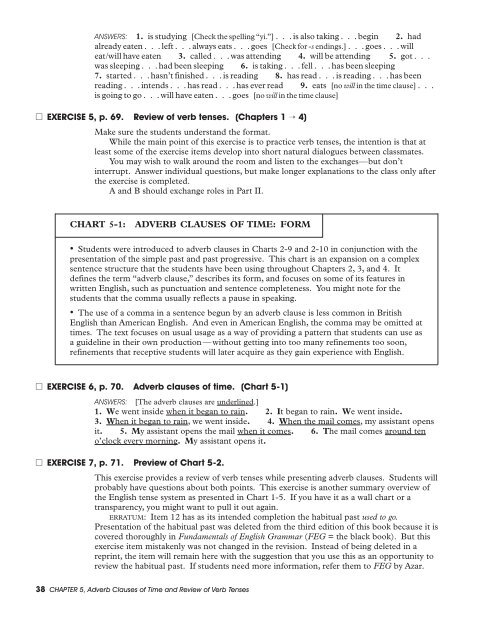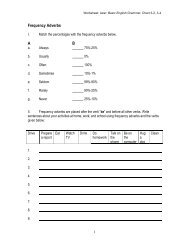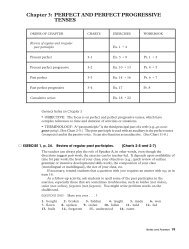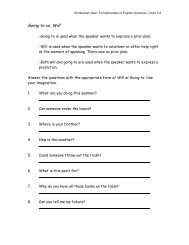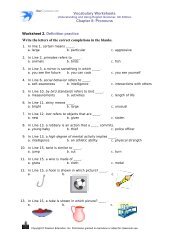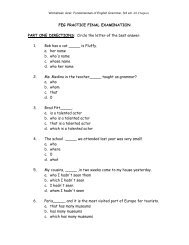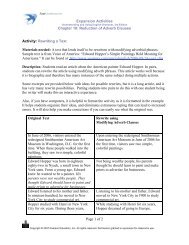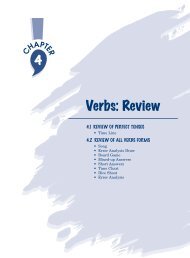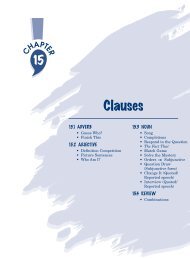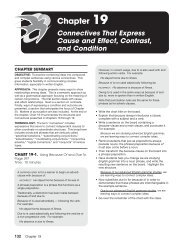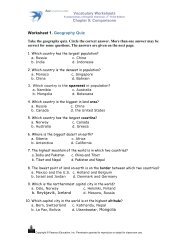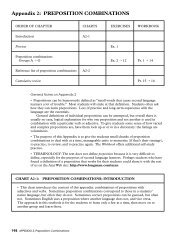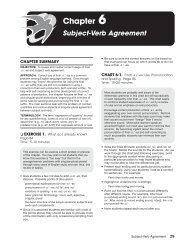Chapter 5: ADVERB CLAUSES OF TIME AND REVIEW OF VERB ...
Chapter 5: ADVERB CLAUSES OF TIME AND REVIEW OF VERB ...
Chapter 5: ADVERB CLAUSES OF TIME AND REVIEW OF VERB ...
You also want an ePaper? Increase the reach of your titles
YUMPU automatically turns print PDFs into web optimized ePapers that Google loves.
ANSWERS: 1. is studying [Check the spelling “yi.”] ...is also taking ...begin 2. had<br />
already eaten ...left ...always eats ...goes [Check for -s endings.] ...goes ...will<br />
eat/will have eaten 3. called ...was attending 4. will be attending 5. got ...<br />
was sleeping ...had been sleeping 6. is taking ...fell ...has been sleeping<br />
7. started ...hasn’t finished ...is reading 8. has read ...is reading ...has been<br />
reading ...intends ...has read ...has ever read 9. eats [no will in the time clause] ...<br />
is going to go ...will have eaten ...goes [no will in the time clause]<br />
EXERCISE 5, p. 69. Review of verb tenses. (<strong>Chapter</strong>s 1 → 4)<br />
Make sure the students understand the format.<br />
While the main point of this exercise is to practice verb tenses, the intention is that at<br />
least some of the exercise items develop into short natural dialogues between classmates.<br />
You may wish to walk around the room and listen to the exchanges—but don’t<br />
interrupt. Answer individual questions, but make longer explanations to the class only after<br />
the exercise is completed.<br />
A and B should exchange roles in Part II.<br />
CHART 5-1:<br />
<strong>AD<strong>VERB</strong></strong> <strong>CLAUSES</strong> <strong>OF</strong> <strong>TIME</strong>: FORM<br />
• Students were introduced to adverb clauses in Charts 2-9 and 2-10 in conjunction with the<br />
presentation of the simple past and past progressive. This chart is an expansion on a complex<br />
sentence structure that the students have been using throughout <strong>Chapter</strong>s 2, 3, and 4. It<br />
defines the term “adverb clause,” describes its form, and focuses on some of its features in<br />
written English, such as punctuation and sentence completeness. You might note for the<br />
students that the comma usually reflects a pause in speaking.<br />
• The use of a comma in a sentence begun by an adverb clause is less common in British<br />
English than American English. And even in American English, the comma may be omitted at<br />
times. The text focuses on usual usage as a way of providing a pattern that students can use as<br />
a guideline in their own production — without getting into too many refinements too soon,<br />
refinements that receptive students will later acquire as they gain experience with English.<br />
EXERCISE 6, p. 70. Adverb clauses of time. (Chart 5-1)<br />
ANSWERS: [The adverb clauses are underlined.]<br />
1. We went inside when it began to rain. 2. It began to rain. We went inside.<br />
3. When it began to rain, we went inside. 4. When the mail comes, my assistant opens<br />
it. 5. My assistant opens the mail when it comes. 6. The mail comes around ten<br />
o’clock every morning. My assistant opens it.<br />
EXERCISE 7, p. 71. Preview of Chart 5-2.<br />
This exercise provides a review of verb tenses while presenting adverb clauses. Students will<br />
probably have questions about both points. This exercise is another summary overview of<br />
the English tense system as presented in Chart 1-5. If you have it as a wall chart or a<br />
transparency, you might want to pull it out again.<br />
ERRATUM: Item 12 has as its intended completion the habitual past used to go.<br />
Presentation of the habitual past was deleted from the third edition of this book because it is<br />
covered thoroughly in Fundamentals of English Grammar (FEG = the black book). But this<br />
exercise item mistakenly was not changed in the revision. Instead of being deleted in a<br />
reprint, the item will remain here with the suggestion that you use this as an opportunity to<br />
review the habitual past. If students need more information, refer them to FEG by Azar.<br />
38 CHAPTER 5, Adverb Clauses of Time and Review of Verb Tenses


